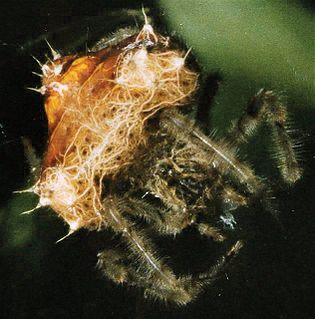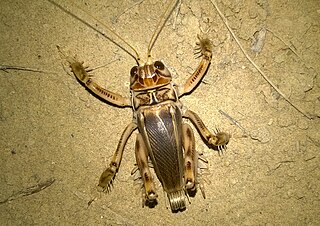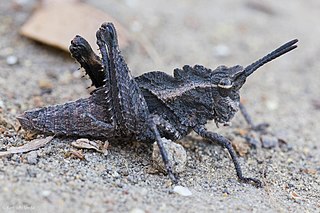Related Research Articles

Lepidoptera is an order of insects that includes butterflies and moths. About 180,000 species of the Lepidoptera are described, in 126 families and 46 superfamilies, 10 per cent of the total described species of living organisms. It is one of the most widespread and widely recognizable insect orders in the world. The Lepidoptera show many variations of the basic body structure that have evolved to gain advantages in lifestyle and distribution. Recent estimates suggest the order may have more species than earlier thought, and is among the four most speciose orders, along with the Hymenoptera, Diptera, and Coleoptera.

Bombyx mori, the domestic silk moth, is an insect from the moth family Bombycidae. It is the closest relative of Bombyx mandarina, the wild silk moth. The silkworm is the larva or caterpillar of a silk moth. It is an economically important insect, being a primary producer of silk. A silkworm's preferred food are white mulberry leaves, though they may eat other mulberry species and even the osage orange. Domestic silk moths are closely dependent on humans for reproduction, as a result of millennia of selective breeding. Wild silk moths are different from their domestic cousins as they have not been selectively bred; they are thus not as commercially viable in the production of silk.

A bolas spider is any of several species of orb-weaver spider that, instead of spinning the typical web, hunt by using a sticky 'capture blob' of silk on the end of a line, known as a 'bolas'. By swinging the bolas at flying male moths or moth flies nearby, the spider may snag its prey rather like a fisherman snagging a fish on a hook. Because of this, they are also called angling or fishing spiders. The prey is lured to the spider by the production of up to three pheromone-analogues.

The X0 sex-determination system determines the sex of offspring among:

The de Havilland DH.60 Moth is a 1920s British two-seat touring and training aircraft that was developed into a series of aircraft by the de Havilland Aircraft Company.
Ordgarius is a genus of orb-weaver spiders first described by Eugen von Keyserling in 1886.

The hammer-headed bat, also known as hammer-headed fruit bat and big-lipped bat, is a megabat widely distributed in West and Central Africa. It is the only member of the genus Hypsignathus, which is part of the tribe Epomophorini along with four other genera. It is the largest bat in continental Africa, with wingspans approaching 1 m, or about 3 ft, and males almost twice as heavy as females. Males and females also greatly differ in appearance, making it the most sexually dimorphic bat species in the world. These differences include several adaptations that help males produce and amplify vocalizations: the males' larynges are about three times as large as those of females, and they have large resonating chambers on their faces. Females appear more like a typical megabat, with foxlike faces.

Dicranurus is a genus of Lower to Middle Devonian odontopleurid trilobites that lived in a shallow sea that lay between Euramerica and Gondwana, corresponding to modern-day Oklahoma and New York, and Morocco, respectively. As such, their fossils are found in New York, Oklahoma, and Morocco. [[Image:|thumb|left|Dicranurus monstrosus fossil]] Their bodies averaged about 1-inch (25 mm) or so, in length, though their large spines made them at least 2 inches (51 mm) in length. It is speculated that such tremendous spines hampered the ability of predators, such as arthrodire placoderms, to attack them, as well as to help prevent them from sinking into the soft mud of their environment. Dicranurus trilobites are distinguished from other odontopleurids by the pair of large, curled, horn-like spines that emanate from behind the glabellum. The genus name refers to these distinctive horns, in fact.

Tripteris is a genus of African plants in the pot marigold tribe within the daisy family.
H. monstrosus may refer to:
P. monstrosus may refer to:

HMS Moth was an Insect-class gunboat of the Royal Navy. Entering service in 1916, Moth had a varied career with service in the Middle East, the White Sea and the Far East in two world wars. Scuttled in World War II during the invasion of Hong Kong, the ship was raised and put into service by the Imperial Japanese Navy as Suma (須磨). The ship remained active throughout the war, before striking a naval mine in the Yangtze River in 1945 and sinking.

Schizodactylus monstrosus or the maize cricket, is a species of large, robust cricket found in Asia, belonging to the family Schizodactylidae. It is found mainly in sandy habitats along rivers, and has large flattened tarsal extensions and wings that are curled at the tip, right above the cerci. They are nocturnal and show a high degree of variation in activity during the day and night. They hide in burrows that they dig on their own during the day.
Paraharmochirus monstrosus is a jumping spider in the genus Paraharmochirus that lives in Papua New Guinea. It has an ant like body.
Hepatocystis carpenteri is a species of parasitic protozoa. They are transmitted by flies of the genus Culicoides and infect mammals.
Monstrosus, monstrous in Latin may refer to:
Cataprosopus is a genus of the snout moth. It was described by Arthur Gardiner Butler in 1881 and is known from India, China, and Japan.
Cataprosopus melli is a species of snout moth in the genus Cataprosopus. It was described by Aristide Caradja and Edward Meyrick in 1933 and is known from China.

Dracotettix monstrosus, the gray dragon lubber, is a species of lubber grasshopper in the family Romaleidae. It is found in North America.

Dracotettix is a genus of dragon lubbers in the family Romaleidae. There are at least three described species in Dracotettix.
References
- 1 2 "GlobIZ search". Global Information System on Pyraloidea. Retrieved May 25, 2017.
- ↑ Cataprosopus monstrosus - BOLD Systems - Taxonomy Browser
- ↑ Japanese Moths
| This Galleriinae-related article is a stub. You can help Wikipedia by expanding it. |